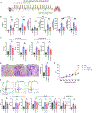TL1A priming induces a multi-cytokine Th9 cell phenotype that promotes robust allergic inflammation in murine models of asthma
- PMID: 38493956
- PMCID: PMC11354665
- DOI: 10.1016/j.mucimm.2024.03.006
TL1A priming induces a multi-cytokine Th9 cell phenotype that promotes robust allergic inflammation in murine models of asthma
Abstract
Multi-cytokine-producing Th9 cells secrete IL-9 and type 2 cytokines and mediate mouse and human allergic inflammation. However, the cytokines that promote a multi-cytokine secreting phenotype have not been defined. Tumor necrosis factor superfamily member TL1A signals through its receptor DR3 to increase IL-9. Here we demonstrate that TL1A increases expression of IL-9 and IL-13 co-expressing cells in murine Th9 cell cultures, inducing a multi-cytokine phenotype. Mechanistically, this is linked to histone modifications allowing for increased accessibility at the Il9 and Il13 loci. We further show that TL1A alters the transcription factor network underlying expression of IL-9 and IL-13 in Th9 cells and increases binding of transcription factors to Il9 and Il13 loci. TL1A-priming enhances the pathogenicity of Th9 cells in murine models of allergic airway disease through the increased expression of IL-9 and IL-13. Lastly, in both chronic and memory-recall models of allergic airway disease, blockade of TL1A signaling decreases the multi-cytokine Th9 cell population and attenuates the allergic phenotype. Taken together, these data demonstrate that TL1A promotes the development of multi-cytokine Th9 cells that drive allergic airway diseases and that targeting pathogenic T helper cell-promoting cytokines could be an effective approach for modifying disease.
Copyright © 2024 The Author(s). Published by Elsevier Inc. All rights reserved.
Conflict of interest statement
DECLARATIONS OF COMPETING INTEREST
The authors have no competing interests to declare.
Figures







References
MeSH terms
Substances
Grants and funding
LinkOut - more resources
Full Text Sources
Medical
Molecular Biology Databases

